Why Batman: Last Knight on Earth Is “The Last Batman Story”
With Batman: Last Knight on Earth, Scott Snyder and Greg Capullo bring their epic Batman saga to an end. We talked to the creators about their grand finale as well as their run as a whole.
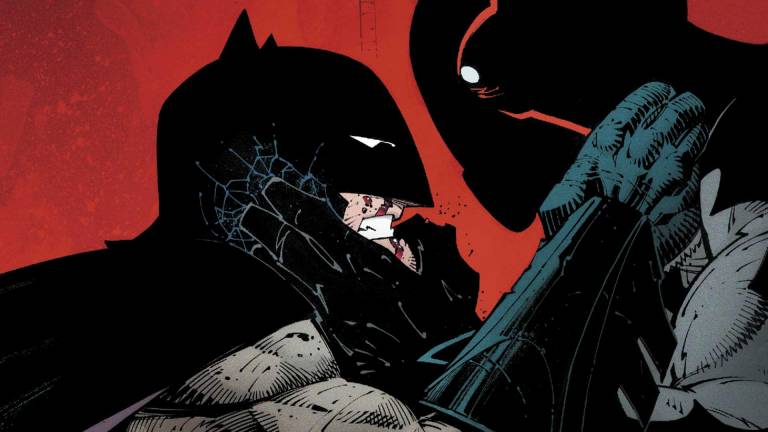
This Batman article contains major spoilers.
When writer Scott Snyder and artist Greg Capullo were tapped to create a new volume of Batman comics for DC’s New 52 reboot in 2011, they didn’t set out to create a saga that would span almost a decade. With early story arcs like “The Court of Owls” and “Death of the Family,” Snyder and Capullo were just trying to tell the biggest Batman stories they could, the ones they’d always wanted to tell.
Their run, which is regarded today as one of the best in the history of the character, reimagined Batman’s origin story in “Zero Year,” killed the Caped Crusader off in “Endgame,” and brought him back to life in “Superheavy.” Then they sent the Dark Knight to space to fight a cosmic threat from a nightmare multiverse in the 2017 Dark Nights: Metal event, which is getting a Wonder Woman-centric sequel later this year. With a resume like that, it’s no wonder this creative team has become synonymous with “big storytelling.”
As Snyder told us in 2015 ahead of his final arc on Batman, “The truth of the matter is that if you’re going to work on a character like Batman, there are thousands of writers that would kill to get on the book so that they could do their one big Batman story. And if you have one that’s a big Batman story that you care about but you choose to do the relaxing, small story, I feel like you might as well move over and let somebody else take the book and swing for the fence on it.”
The story doesn’t get any bigger than the three-part Batman: Last Knight on Earth, a post-apocalyptic road trip billed as “the last Batman story.” It’s set on a ravaged Earth where most heroes have died — except for the Dark Knight, who has found a way to cheat death (because Batman always wins). The miniseries, which is out now in hardcover, is the conclusion to Snyder and Capullo’s work on Batman and a love letter to almost a decade of storytelling. They even reunited with all-star Batman inker Jonathan Glapion and colorist FCO Plascencia to finish their story.
Den of Geek spoke to Snyder and Capullo at NYCC 2019 ahead of the release of the final issue of Last Knight on Earth about finally bringing their run to an end, why Batman and the Joker are destined to dance forever, the legacy of the Court of Owls, and what they hope readers will take from their time in Gotham.
Batman’s Inferno
In the span of eight years, this creative duo has told every kind of Batman story there is, from action-adventure and horror to science fiction, detective yarn, and mech vs. kaiju disaster tale. But Last Knight on Earth is by far their weirdest Batman story yet. The world is a wasteland covered in desert. On the blood-red sands walk zombies with green power rings that conjure up giant killer babies. The earth is plagued by Speed Force storms — giant, violent tornadoes made up of the distorted bodies of past Flashes that beg Batman for help — that can age you into bones and dust in milliseconds. All around Batman lie memories of the dead.
And then there’s the Joker’s decapitated head in a jar, which narrates the story and acts as the Caped Crusader’s guide through Hell, like Virgil from Dante’s Inferno but much funnier. Together, they travel from Coast City to the underworld to a dystopian Gotham City where Batman makes his last stand against an evil tyrant named Omega, a masked villain who has a connection to Bruce’s past.
The storytelling is absolutely insane, and that’s saying something when it comes to this creative team, who once retired Bruce and replaced him with a mech suit-wearing Jim Gordon. So, how did Snyder come up with this finale for his version of Batman?
“There’s a really interesting natural progression of the character, because this was the story that I thought of as the last story that we would do for years,” Snyder says. “I didn’t come up with it at the end of our run, I came up with it back when we were doing ‘Zero Year,’ the bones of it.”
The comic book industry is known for its resistance to change. Bold, new takes on characters are great for selling first issues but comics always eventually return to the status quo as one creative team leaves and another takes over. Yet, rarely does a creative team actually get to give their version of a character a genuine beginning, middle, and end. Most runs tend to flow into each other.
But after giving his Batman a beginning in “Zero Year,” which follows a younger Bruce Wayne from tragedy to donning the cape and cowl for the first time, Snyder hoped to give him a definitive end.
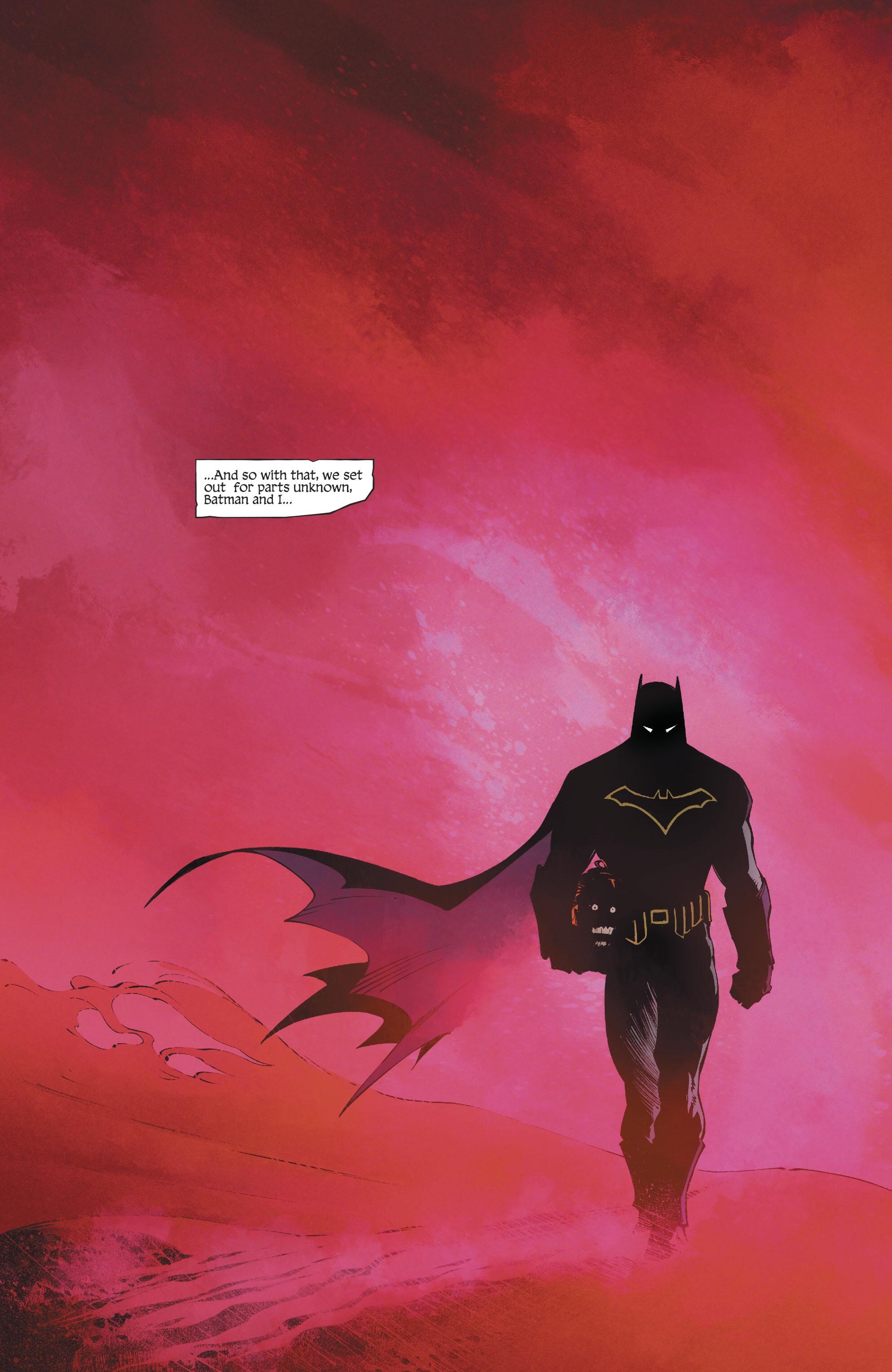
“It really came from this moment when I saw [Snyder’s Batman predecessor] Grant Morrison at San Diego Comic-Con when we were first starting Batman, and he told me to come up with an origin and a death for our version of Batman that was particular to ours,” Snyder explains. “The death came pretty early too. You can see the bones of it in the story I did for Detective Comics #27 (2014) with Sean Murphy, where Batman sort of figures out a way to always make sure there’s a Bruce Wayne Batman with his final invention, his cloning machine.”
This “cloning machine,” which creates a new Bruce Wayne aged to the moment when he decided to first become a Bat, plays a vital role in Last Knight on Earth. The first issue actually opens with the original Batman’s death in Crime Alley and his rebirth as a younger clone several decades later. Snyder and Capullo use this setup to ask big questions about what it means to be Batman and why the world needs him as a symbol for hope.
“I was thinking about how I wanted Batman to make my kids brave, the way Frank Miller wrote so much to my fears as a kid. The Cold War, urban decay in New York, all that stuff I grew up with here, I felt in his work,” Snyder says of writing a Batman story that would inspire hope in his own children and a new generation of readers.
“What would they be afraid of?” Snyder asks of this new generation. “They’re afraid of shooters. They’re afraid of terrorism and they’re afraid of apocalyptic scenarios that are in the air all the time because of climate change, global dissolution, the whole global community falling apart. I think people have apocalyptic worries right now.”
At a time when DC was pushing darker, grittier takes on heroes both on the page and on the big screen, Snyder and Capullo did something completely different with Batman. Their version isn’t just a symbol meant to inspire fear in evil-doers and the kinds of thugs who would make a child an orphan. Throughout their run, Batman inspires the people of Gotham to be better, to get back up after they’ve been knocked down, to keep fighting. This is a quality usually reserved for “lighter” heroes like Superman and Wonder Woman, but Snyder and Capullo instilled a goodness in Batman that you might not even know was there if all you knew about the character is what you saw in the recent movies.
In Last Knight on Earth, this new, younger Batman faces his toughest challenge yet: a broken world that’s stopped believing. But he walks through Hell for us so that hopefully one day he can show us paradise.
Dance with the Devil in the Pale Moonlight
Last Knight on Earth, like much of their work on Batman, pays tribute to one of the greatest rivalries in comic book history. No great Batman story is complete without a visit from the Clown Prince of Crime, but Snyder and Capullo completely turn that relationship on its head. In a future when virtually all of Batman’s allies and loved ones have died, the Joker becomes the Dark Knight’s only friend.
Despite the fact that the Joker has appeared in many of their stories up to this point, the team keeps finding new ways to explore this relationship. Snyder once described “Death of the Family” as a comedy and “Endgame” as a tragedy. It’s a deadly dance that reaches its conclusion in Last Knight on Earth but not in the way you think.
So why can’t the hero exist without his greatest villain, even after the world has ended?
“They kind of mirror each other in a way, [but] one’s a dark reflection,” Capullo says. “They’re a lot alike in a lot of ways and one of the few things that separate Batman is he knows not to cross the line of killing. Because he could become just as bad as that other guy, because he’s got the same kind of issues, you know? And so he could easily become a Joker.”
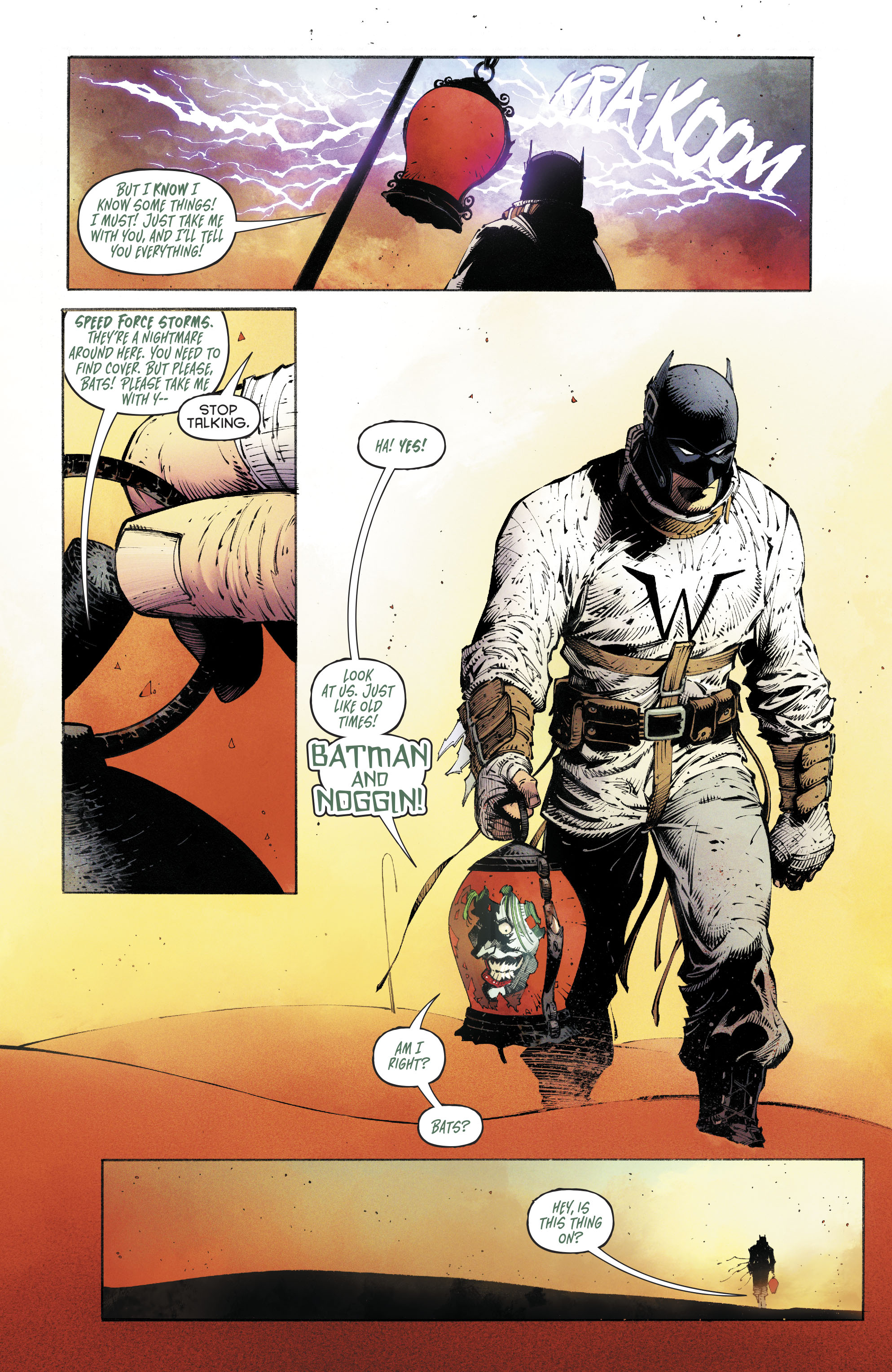
Nowhere is the fragile sanctity of Batman’s most important rule — no killing — more apparent than in the villain of the piece, Omega, who is later revealed as an older, heavily scarred, and power-mad Bruce Wayne. Although thought dead after an angry mob under the influence of Lex Luthor rushed the Hall of Justice and murdered the Justice League, this Bruce survived and took over the world as Omega. His ultimate plan is to use Darkseid’s Anti-Life Equation to bend the remaining people of Earth to his will. He believes this is the only way to save humanity from itself.
Snyder, who explored a similar idea with the Batman Who Laughs, a grotesque Jokerized Batman from the Dark Multiverse who killed his entire family and rogues gallery on his Earth, uses Omega to show what would become of the Dark Knight were he to lose himself. As the Joker says in Alan Moore and Brian Bolland’s The Killing Joke, it only takes “one bad day.”
“I think for me Joker is always the inhuman opposite of Batman. Whatever Batman is trying to prove, Joker’s proving the opposite,” Snyder says. “When we were doing Batman, Batman was very much about proving that every action matters. He’s trying to get everybody to be inspired to get out and do something good. Joker was always saying, ‘Nothing matters. Everything is empty. There’s no story. It’s just empty existential, inconsequential, nothing.’ And so whatever Batman is trying to do to make himself feel effective, Joker will reverse it. And it’s why I love him as a character. He’s sort of the embodiment of evil in that regard. Whatever you’re most afraid of, he brings to life for you.”
Ironically, the Joker goes through a very different transformation in Last Knight on Earth and ends up helping this new Batman…in his own way. Let’s just say Batman is going to need a bigger cave.
Night of the Owls
The Joker isn’t the only classic villain who gets an encore in Last Knight on Earth. Twisted versions of Scarecrow and Bane haunt an elderly Alfred, while the last remnants of the Earth’s military don masks made of bandages similar to the one worn by Hush. A decrepit Lex Luthor spends his final days inside the Fortress of Solitude trying to bring the Man of Steel back to life.
The Court of Owls, the underground crime organization that ran Gotham from the shadows with an army of undead owl-themed assassins, plays a major role in the book. How could they not? The Court remains one of Snyder and Capullo’s biggest contributions to the Bat mythos. In the years since their introduction in 2011, the Court of Owls has leaped off the page and appeared on TV’s Gotham, the animated movies, and is rumored to be the villain of an upcoming Batman video game.
What is it about the Court of Owls that’s given them such staying power?
“The scariest thing is when the things that you feel most comfortable with attack you,” Snyder says. “I think that’s why I loved Stephen King growing up. He does that over and over with things that are totemically comfortable like your car Christine. Your dog Cujo. Your father Jack in The Shining. It’s always the things, these American icons or these things that you feel safe with, that suddenly turn on you.”
As Batman learned in the first arc of Snyder and Capullo’s run, the Court of Owls had manipulated the events of Gotham City for centuries. Suddenly, The Dark Knight didn’t know his city as well as he thought.
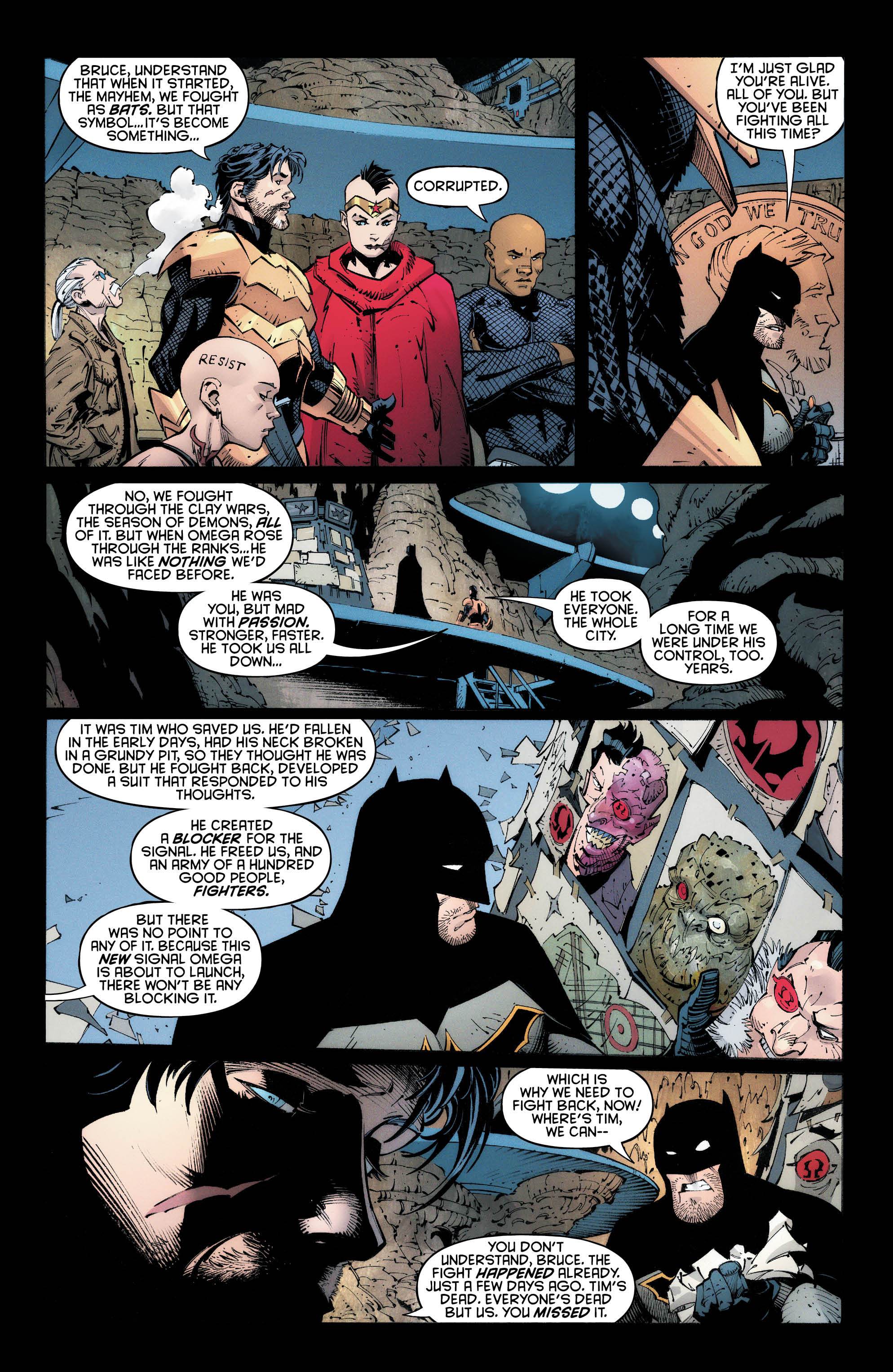
“For Batman, I was thinking what is it that could turn on him? And it’s Gotham itself being like, ‘You don’t know me as well as you thought you did. Everything you thought you knew is just this much and I’m a big mystery,’ Snyder says. “It felt like the kind of horror that I love. So I hope that’s why it sticks. And zombie owl assassins are pretty cool.”
The Court of Owls storyline also led Bruce to some major discoveries about his own past, namely that he possibly had a secret younger brother named Lincoln March, aka Thomas Wayne Jr. Batman never truly solved this mystery, and Snyder has said that not writing a second Lincoln March story is “one of his big regrets.” But it’s possible that the legacy of the first story will live on long enough for another writer to pick up the yarn.
“What he did was brilliant,” Capullo says of Snyder’s writing in that early arc. “For Scott to drop this bomb in there and go, ‘It’s existed for hundreds of years without you knowing a damn thing about it.’ I just got chills just saying it again. It’s genius. I think that’s why it has so much appeal and it makes its way into these other things.”
Snyder and Capullo bring the Court of Owls’ story full circle in Last Knight on Earth. Long after the Gotham they once ruled from the sewers has been reborn in Omega’s image, the Court of Owls is now led by Dick Grayson and Barbara Gordon. In this dystopian future, the owl has unexpectedly evolved into the symbol of hope and justice — just another example of how Gotham can still surprise Batman.
Batman Forever
The Court isn’t the only thing that’s changed after eight years of Batman stories. The creators have changed both in how they work as a team and how they approach telling stories.
“It’s funny because Scott started off giving me ridiculous amounts of script for the 24-page story,” Capullo says of working with Snyder in the early days. “Issue one was over 40 pages of script. I’m going, ‘Are you crazy, kid?’ Because I was used to working from phone calls with [Spawn collaborator] Todd [McFarlane], and I’d jot down notes. And I would tell Scott all the time, ‘You don’t get paid by the word, just let me do the heavy lifting.'”
It’s no secret that there was friction between the writer and the artist at first, and they weren’t sure they were going to be able to work together. Snyder was still a relative newcomer to comics in 2011, while Capullo was a veteran who’d started his career at Marvel Comics in the ’80s and moved on to Image for a long run on Spawn in the ’90s. Capullo was used to working under the “Marvel method,” named for the process pioneered by creative pairings like Stan Lee and Jack Kirby or Stan Lee and Steve Ditko, where an artist draws an entire story based on a short summary or notes from the writer. The writer then goes back and adds dialogue to the finished art. This was not how Snyder liked to work. Fortunately, the team learned how to collaborate and Snyder and Capullo even became close friends in the process.
“Finally, he’s gotten it,” Capullo says. “Now the scripts go, ‘Okay, here’s what happens from pages 8 to 24.’ So he’s completely changed. He’s realized this is much easier.”
You can see how this partnership developed from one issue to the next. As Capullo has said previously, the artist feels that their early issues of Batman were a bit too verbose and “a lot of the lettering in the first chapter covered up the art.” But you can see how the team’s approach loosened up in later issues, with the art doing more of the talking, especially in the action-packed and splash-heavy “Zero Year.”
“I don’t even recognize the way I used to write when I look at those old scripts,” Snyder says of his early collaboration with Capullo. “I never do that unless somebody asks anymore. I don’t write full scripts, but I write closer to full script than what I show him. Like I’ll write it page by page to make sure it fits beat by beat. And then I undo the pagination and press send, so that he has more room to decide how to choreograph it. I just don’t want to put too much in so that I’m jamming it, or too little, you know?”
Snyder believes that change is important in order for an artist to grow: “That’s the way it should be. No matter what creative field you are, you should always be changing and evolving and seeing things in a different and hopefully better way.”
Looking back at their time with Batman, there are too many iconic moments to count: Batman trapped in the Court’s labyrinthine underground base, the Joker wearing his own face as a mask, the Caped Crusader’s epic fight with Doctor Death above Gotham City, the Joker toxin attack that turned everyone in Gotham City into a laughing maniac, and the Dark Knight’s mech battle with a giant monster called Bloom.
Snyder’s favorite moment of all? It’s a single page from Batman #50 (2016).
“I think my favorite moment might still be when he came back after being dead and Jim Gordon is Batman at the moment, and [Bruce] comes back in the real Batman costume and he’s like, ‘Hello Jim, who died and made you Batman?'”
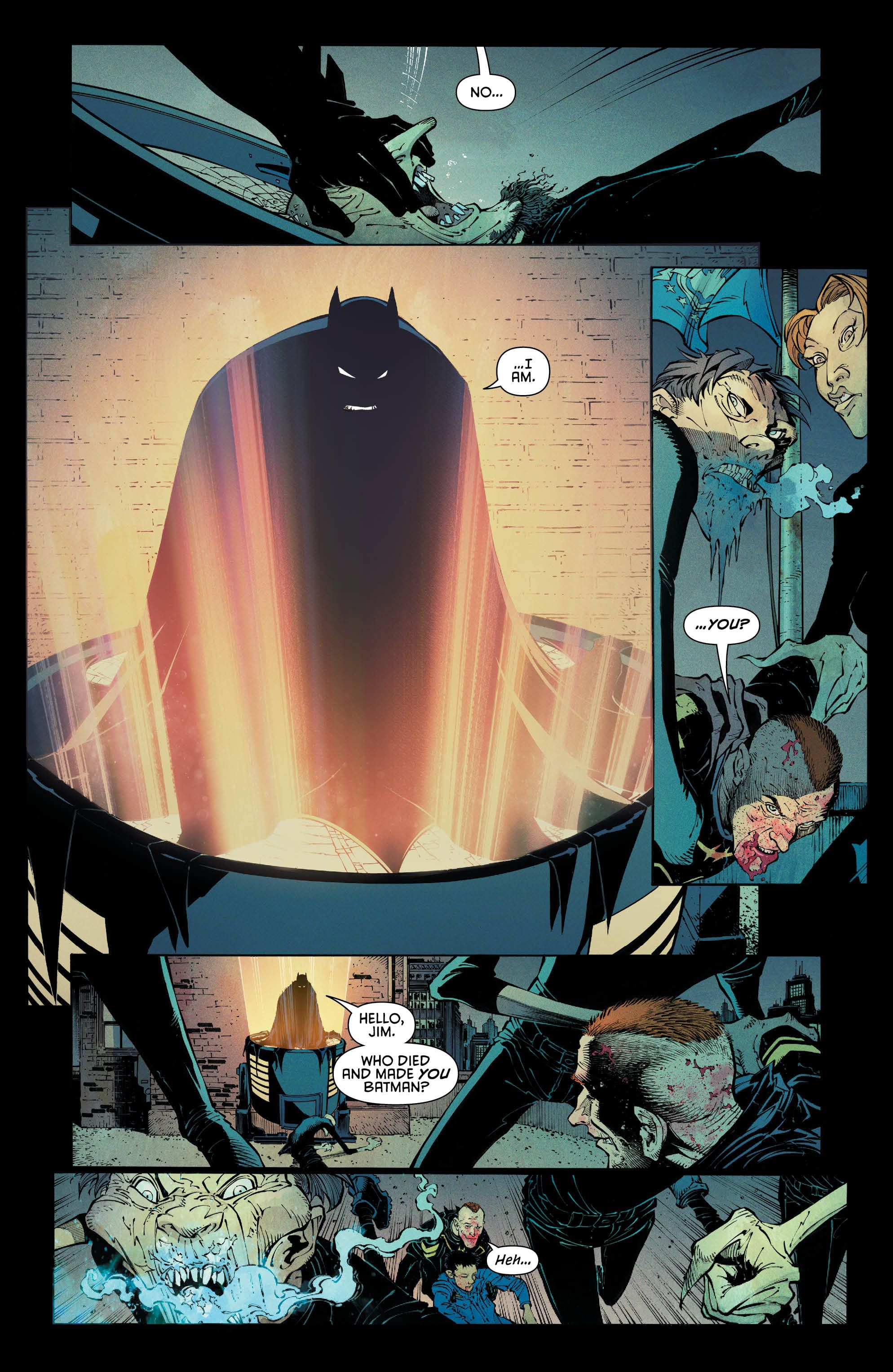
But eight years is also a long time. While Snyder recently wrapped up a 39-issue run on Justice League and Capullo took a break from DC to draw a creator-owned book for Image, most of their work between 2011 and 2019 has been tied to Batman. It’s not surprising, then, that both creators have called Last Knight on Earth the last Batman-centric story they’ll work on together.
“I think we both want to do other things,” Capullo says. “It feels good and I think we’re leaving on a high note. I’m grateful that people received what we did, and they can judge it for how they judge it. I just did my best with what [Scott] was giving me, and that’s it, man.”
Next up for the team is Dark Nights: Death Metal, a new event book that looks more insane than anything they’ve attempted before. It’s a dark, horror-tinged story that ties the different eras of DC history into a cosmic battle against the evil goddess Perpetua and the Batman Who Laughs. Batman’s in the story, of course, as the leader of an army of zombies that he controls with a Black Lantern ring, but Death Metal is really a Justice League story that picks up where Snyder’s run left off.
As their time with Batman comes to an end, what do the creators hope readers take away from their eight years of storytelling? What is the message?
“I hope that what people take away from ours is that we tried really hard to make it personal. And for me, what made our Batman personal was the idea that he was less about scaring bad guys into the shadows than inspiring people, good people, to come out into the light and try and do something effective with their lives. He was more a symbol of hope and inspiration,” Snyder says. “I think there’s still a lot of fears, all of these kinds of worries about big cataclysmic disasters. And Batman says, ‘Get out of your house, do something good today.'”
Batman: Last Knight on Earth is out now.
